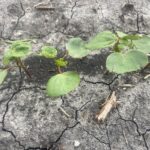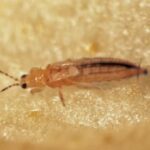 Cotton maturity ranges from cotyledon to 1/2-grown square. Some fields need to be scouted for thrips, while others are beyond the thrips damage window and need to be checked for cotton fleahopper.
Cotton maturity ranges from cotyledon to 1/2-grown square. Some fields need to be scouted for thrips, while others are beyond the thrips damage window and need to be checked for cotton fleahopper.
Seedling cotton should be monitored for thrips until 5 or 6 true leaves are on the plants. I usually think the growing conditions in late April are good enough to overcome thrips feeding, but some fields have high numbers of thrips that are causing significant damage.
Thrips are slender, straw-colored insects about 1/15 inch long, with piercing-sucking mouthparts. Adults are winged and capable of drifting long distances in the wind. They attack leaves, leaf buds, and very small squares, causing a silvering of the lower leaf surface, deformed or blackened leaves, and loss of the plant terminal.
Treat for thrips when there are more than 2 thrips per true leaf and feeding injury is noticeable.
Once cotton is past 5-6 true leaves there are usually squares on the plant. The cotton fleahopper is the primary cause of square losses and their presence should be monitored. Cotton fleahopper feeding on small squares (< matchhead size) can result in the abscission of the square. From my field scouting, I have seen square sets above 90% square retention which is evidence of either good management or low populations.
Recent research has caused me to adjust my economic threshold down from 15 fleahoppers per 100 plants to 10 per 100 plants. The crop is usually safe after the first week of bloom.
More information of cotton insect management can be found HERE. managing-cotton-insects-in-texas
Herbicide Injury
Herbicide injury has been found in a number of fields in Victoria County. Much of this appears to be symptoms of hormone type herbicides. Research conducted by Extension Agronomist across Texas has found it difficult to predict the effect of 2,4-D injury on cotton based on the severity of symptomology.
Sometimes little injury may cause significant yield losses while greater amounts of injury did not affect yield. Younger cotton tended to be more adversely effected than older cotton, and poor growing conditions following the herbicide exposure may increase the effect on yield. But these results were not consistent from trial to trial or across years.
In short, we will have to wait and see what effect the injury has on the field and each field may respond differently.
Monday morning
Crop Scouting Meeting
When: 9 am, Monday, May 6
Where: FM 1679, just south of Sanders Rd.
We will be looking at how to scout for cotton fleahoppers, plant growth regulators, and other topics.

